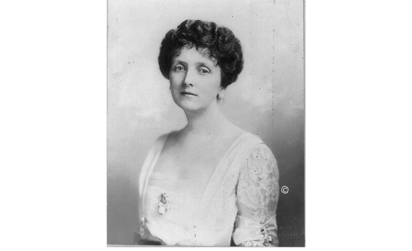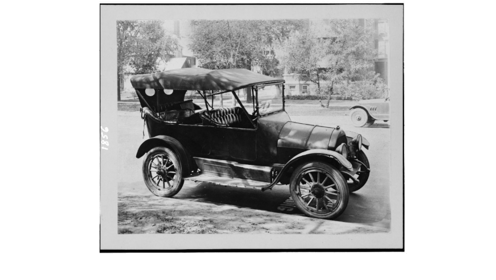By Elizabeth Sindelar-Loy
Out of all the female automotive pioneers I could have chosen, it’s completely understandable if it seems odd to have picked Emily Post. In all honesty, she wasn’t even in my top ten list to write about until I stumbled across her story. The more I researched her legacy with the automotive industry, the more her story became intriguing. She used her writing to fight against the societal norms of the day so that women could have their place in automotive history. With her typewriter she proved women were capable drivers that could navigate the roads without a male present.
 To the vast majority, Emily Post is known as the epitome of etiquette yet that was just one side of her personality. Albeit the famous side. Therefore, often an overlooked fact is Emily was considered rebellious despite her high-society upbringing. Her father, Bruce Price, was an American architect known for designing the famous Tuxedo Park in New York as well as many other well-known architectural landmarks. Emily’s mother, Josephine (Lee) Price was the daughter of a wealthy coal baron. Post married a prominent banker, Edwin Main Post, in 1892 shortly after her debut to society. The marriage ended in divorce due to her husband’s penchant for chorus girls and fledgling actresses that made him the target of blackmail.
To the vast majority, Emily Post is known as the epitome of etiquette yet that was just one side of her personality. Albeit the famous side. Therefore, often an overlooked fact is Emily was considered rebellious despite her high-society upbringing. Her father, Bruce Price, was an American architect known for designing the famous Tuxedo Park in New York as well as many other well-known architectural landmarks. Emily’s mother, Josephine (Lee) Price was the daughter of a wealthy coal baron. Post married a prominent banker, Edwin Main Post, in 1892 shortly after her debut to society. The marriage ended in divorce due to her husband’s penchant for chorus girls and fledgling actresses that made him the target of blackmail.With two boys to support and raise, Emily needed to earn an income (she would become wealthy after her mother’s passing years later). Therefore, when the boys were old enough for boarding school, Post went against societal norms and worked! She returned to writing, something that had been put aside while married. Long before establishing herself as the authority on etiquette, Post was a pioneering female journalist with her detailed account of elite automotive travel chronicled the history of the southwest.
Americans had been spending $500 million to travel Europe. Railroads, politicians, and those with commercial interests in cross-country motoring wanted people to “see America first”. Traveling across the country to the Pacific to view national treasures was advertised as a patriotic duty. The campaigns to get Americans to travel west was targeted to wealthy Easterners like Post. When the war broke out in 1914, traveling Europe became potentially fatal therefore Americans finally turned their eyes towards the west. Railroads appealed to those who wanted to travel with ease and comfort. Automobile travel on the other hand appealed to those who wanted to travel in the most expensive form of transportation at the time.
Emily was part of the pre-war generation group of middle-class women who wanted their gender to be included in the sport of driving instead of taking a back seat to the men. In 1915, the middle-aged, divorced mother of two embarked on a cross-country road trip. Even with her son driving the automobile, her age and status made the journey significant and profound for the time. Following her cross-country trip, Post published “By Motor to the Golden Gate” in 1916 detailing her journey from New York City to San Francisco. Included in the book, Post told women they didn’t need a male chaperone in the car and that it was perfectly proper for a woman to drive herself or even drive a male passenger.
The cross-country road trip was published by Collier’s Weekly. Emily had written about her journey in an entirely different perspective than previous author’s. She included all the elements that made a road trip memorable. Post wrote the 27-day trip in such detail that readers felt they were along for the ride as Emily, her son and cousin traversed the country. Post’s editor had given her permission to turn back if the journey became uncomfortable, but Emily toughed it out. She even included in her writing the nauseating climbs along muddy roads, sleeping in the desert, the elegance of stylish downtown hotels and the “eccentric topsy-turviness” of Midwestern Cities.
In 1949 Emily published “Motor Manners: The Bluebooklet of Traffic Etiquette” at the request of The National Highway Users Conference. The industry-based organization hoped encouraging good manners would create safer drivers. Emily shocked readers in the book’s pre-face by writing, “Far too little traffic courtesy is shown on our highways. In fact, this lack of courtesy by highway users contributes not only to confusion and traffic congestion, but bad motor manners can all too often result in MURDER.”
Following the success of her Etiquette publications, Emily continued to be an advocate for women to take their place on the road. Within her rules of etiquette, she continued to popularize the idea of women behind the wheel. Therefore, for all the females like myself fighting to be viewed as equals in the automotive industry we have Emily Post to thank for leading the way.


Comments